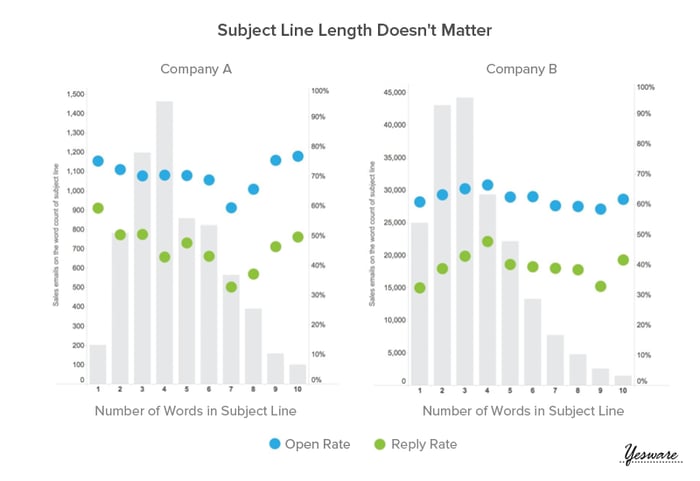In Inbound Recruiting, email is probably the most important tool after the Landing Page.
Our work on Marketing Automation scenarios - although in this case, we should be talking about Recruiting Automation - yields some very useful insights into the relevance of emails to candidates.
Of course, there is no ONE automated email text that can be relevant in all situations, and the response rate to a fully personalized message will always be higher.
Nonetheless, here are four helpful rules to know to increase your open, click and response rates.
1 - The subject line
When you sit down at your desk in the morning and scroll through your list of unread emails, what will make you decide to delete them or open them ?
The subject line, of course!
The words you use are critically important to your candidate-nurturing.
Here are 4 rules to follow to optimize your taglines:
Tailor it to your Candidate Persona
Did you know that simply including the candidate's name in the subject line increases the open rate by 26% ?
But don't stop there - get a little creative by using phrasing that references information gathered during the Candidate Persona.
For example, if you know that the keyword " Big Data " is very important to your candidate, include it in your subject line.

By introducing personalization elements in your object, you increase your chances of opening
Don't talk about job openings, talk about career development
A passive candidate is not interested in a position.Ask them if they are willing to think about their career path rather than detailing the benefits of a position.
Talk about common relationships
If you have mutual acquaintances with a candidate via LinkedIn, don't wait until the body of the message to mention it.
Referring to a mutual connection in the subject line of your email will increase your chances of getting a response by nearly 30%.
The reason is simple: the candidate may not have heard of you, but by naming a friend, colleague or acquaintance in the subject line of the email, you are offering a bond of trust and giving the recipient a reason to talk to you.
In English, this is called an " endorsement of trust ", a seal of approval that makes a huge difference in the decision-making process.
Be honest
The temptation of a teaser title can be great, but beware if the content of your email doesn't live up to your promise !
Also, in their subject lines, some recruiters suggest to candidates that they have already spoken to each other or use "Re :" to imply that their message is part of a pre-existing email chain.
This may get a few clicks, but it mostly runs the risk of irreparably damaging the employer brand and often guarantees that candidates never apply!
Some other lessons from Marketing
Every second, nearly 2.5 million emails are sent around the world, a good portion of which come from Marketing !
There is therefore a lot of data available on the effectiveness of email subject lines and especially to answer the question " Does length matter ? ".
Personally, I prefer collected headlines because they are faster to parse through a list and more importantly, easier to read if they are opened on a mobile (nearly half of all email opens are via a smartphone).
To answer more scientifically, Yesware compared data from two anonymous companies and found no statistically significant trend around word count, as shown in this diagram.

The length of the email subject line does not impact the open or response rate
2 - Personalization
The concepts of automated emails and personalization may seem antinomian.
Yet, there are indeed different different ways to address messages in the right context, accompanying each person on their individual conversion path. In Marketing, this is called fine segmentation.
By being on the lookout for every opportunity to trigger personalized contact with your candidate, your message will feel natural and you'll build trust for engagement.
It's important that each new message is a conversation resulting from previous conversations or measurable interactions beforehand.
This is possible with tools like Hubspot where you'll be able to know exactly what content a candidate was particularly interested in or if they diligently frequent certain types of job postings.
3 - The call to action
Every email you send should have a clearly identifiable next action. To do this, guard against vague wording: you need to be very specific!
At the end of your message, the candidate should have a clear idea of what you expect from them.
This could be, for example, :
- From a simple response of " yes, I am listening to the market "
- To agree to a call
- To arrange an interview
The research of psychologist Robert Sutton clearly demonstrates this, people are more receptive and willing to help if they are given clear directions.
Don't hesitate to include a visible call-to-action in the body of your email to make it easier for your candidate.
Be careful, though, not to rush the candidate by wanting to talk to them too quickly about a position for them. A passive candidate is in no hurry, set yourself at their pace.
4 - Follow-up
Even though a follow-up isn't technically part of building the perfect recruitment email, it's an essential part of any sourcing/nurturing strategy.
By continuing the exchange while other recruiters have stopped, you have a great chance of winning the bet !
Yet, it's rare for candidates to get a good follow-up email.
There are three main reasons for this:
- Lack of time: recruiters tend to be quite busy and don't see the value in following up with candidates in an organized way
- A certain arrogance around this idea: " Bah, even offering him a great offer he doesn't respond, I don't see why I'd waste my time with him " If a salesman reasoned like that, he wouldn't last long in his job !
- Fear of rejection: if your attempts to follow up fail, it is not uncommon to feel a sense of rejection. Some studies show that rejection affects the human brain in the same way that physical pain does. Recruiters want to avoid this, it's only natural !

Good follow-up on your recruitment emails is a must
It's important to know that if candidates aren't responding, it could be that they're busy too, especially if they're passive-candidates.
Replying to your message is probably not their priority, and it's also possible that they simply didn't see your first message. Silence does not mean no!
The best candidates have a pretty full inbox, so your email may have gone unnoticed.
In this case, don't hesitate to follow up with them! A study by the Lever Company shows that it can take up to 4 emails to get a response from the candidate.

Only 50% of candidates will respond to your first email, why not take it a step further?
You're on your own !
You now have solid knowledge to fine-tune your email blasts to your candidates.
While creativity is a good card to play, remember that it is often persistence that pays off.
When the issue is very large numbers of applications, then Marketing Automation and Inbound Recruiting solutions work great.








